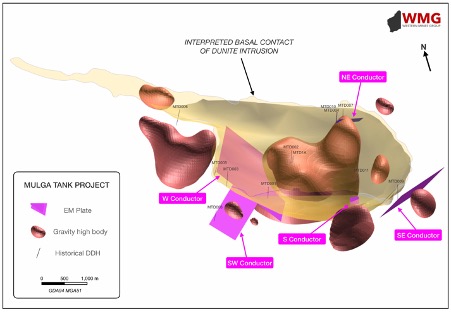Western Mines Group Ltd (ASX:WMG) has identified five major bedrock conductors in the Central and Southern Sectors of the MLEM survey at its flagship Mulga Tank Ni-Cu-PGE Project in Western Australia.
Managing Director, Caedmon Marriott, said WMG’s systematic exploration approach combining geophysical, geological and geochemical vectoring work continues to build a robust exploration model for the discovery of multiple nickel sulphide deposits within this very large and highly prospective ultramafic intrusion.
“The ongoing MLEM survey at Mulga Tank has now completed the Central and Southern Sectors of the intrusion and is moving on to the final Northwest Sector,” Mr Marriott said.
“Interim results from the survey highlight 5 major bedrock conductor targets that fit our growing understanding and exploration model of the intrusion. These geophysical anomalies haven’t been tested by historical drilling, whilst our geological and geochemical vectoring work, in parallel with the geophysical survey, further supports them as exciting drill targets.
“All preparations for an initial 10 to12 hole diamond drilling programme are well underway to drill test this project as soon as we can.”
WMG is currently undertaking a high-powered Moving Loop Electromagnetic (MLEM) survey at Mulga Tank to explore for buried electromagnetic bedrock conductors that could be associated with deposits of massive Ni-Cu-PGE sulphides. This survey is part of series of ground geophysical methods being used to explore the Mulga Tank Dunite Intrusion.
To date the survey crew has completed the Central and Southern Sectors of the intrusion and is now moving on to the final Northwest Sector. Interim results from the survey are presented below, with final results including the Northwest Sector, anticipated around mid-late March.
The MLEM survey highlights five major bedrock conductor anomalies within the Central and Southern Sectors of the intrusion. Combined with WMG’s geological interpretation and nickel geochemical vectoring work, these MLEM conductors present themselves as robust drill targets.
Based on a number of factors the western margin and basal contact of the dunite intrusion is emerging as a priority exploration target and is the site of the largest and strongest MLEM target – W Conductor. The W Conductor itself has not been tested by any historical drill holes, whilst previous holes MRC09, MTD003 and MTD005 to the southwest provide strong support for the prospectivity of this target area:
MRC09 – vertical BHP hole (1983) on the intrusion margin showed 6m at 0.94% Ni from 63m to end of hole, including 2m at 2.00% Ni from 67m to end of hole
MTD003 – 1m at 1.12% Ni and 0.45g/t Pd from 209m close to basal contact of intrusion – the depth, Pd credit and visible sulphides in the core providing strong indication for primary nickel sulphide mineralisation processes in this area
To the north of holes MTD003 and MTD005, the western margin of the dunite intrusion remains completely untested for approximately 2.5km, including for 1.2km through the strongest central portion of the W Conductor.
Mr Marriott said WMG’s evolving geological exploration model for the project suggests this is a key target area that will be drill tested as part of the initial diamond drilling programme.
For further information please visit: https://www.westernmines.com.au/












